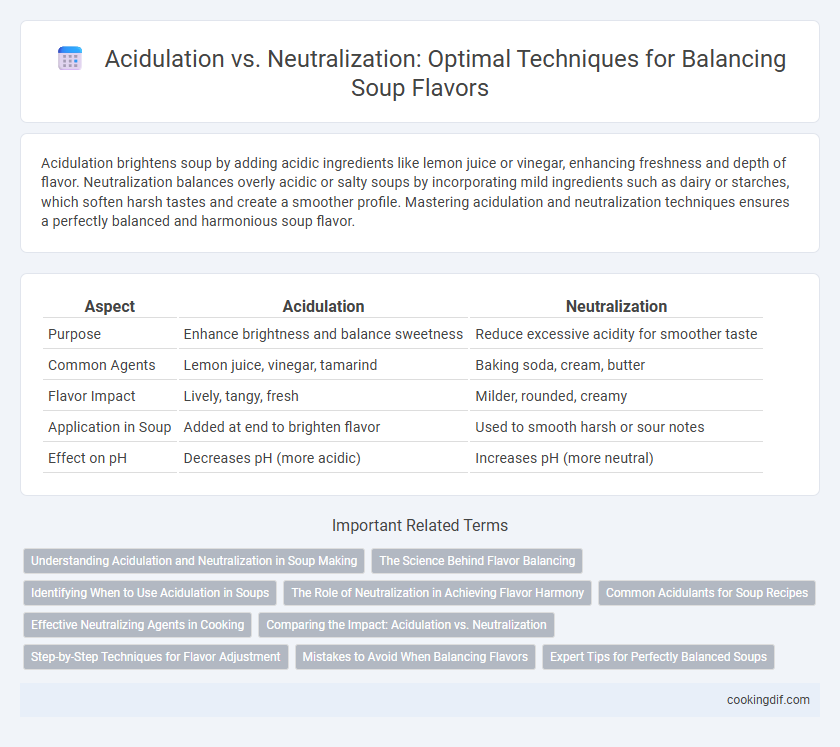Acidulation brightens soup by adding acidic ingredients like lemon juice or vinegar, enhancing freshness and depth of flavor. Neutralization balances overly acidic or salty soups by incorporating mild ingredients such as dairy or starches, which soften harsh tastes and create a smoother profile. Mastering acidulation and neutralization techniques ensures a perfectly balanced and harmonious soup flavor.
Table of Comparison
| Aspect | Acidulation | Neutralization |
|---|---|---|
| Purpose | Enhance brightness and balance sweetness | Reduce excessive acidity for smoother taste |
| Common Agents | Lemon juice, vinegar, tamarind | Baking soda, cream, butter |
| Flavor Impact | Lively, tangy, fresh | Milder, rounded, creamy |
| Application in Soup | Added at end to brighten flavor | Used to smooth harsh or sour notes |
| Effect on pH | Decreases pH (more acidic) | Increases pH (more neutral) |
Understanding Acidulation and Neutralization in Soup Making
Acidulation in soup making involves adding acidic ingredients like lemon juice, vinegar, or tomatoes to brighten flavors and enhance overall taste complexity. Neutralization occurs when acidic components are balanced by alkaline substances such as baking soda or dairy, which reduce sourness and create a smoother flavor profile. Mastering acidulation and neutralization techniques allows cooks to achieve perfect flavor harmony and depth in soup recipes.
The Science Behind Flavor Balancing
Acidulation enhances soup flavors by adding acidic ingredients like lemon juice or vinegar, which activate taste receptors and brighten the overall profile. Neutralization involves balancing excessive acidity or bitterness through alkaline substances such as baking soda or dairy, stabilizing pH levels for a smoother taste experience. Understanding the interplay between acids and bases at the molecular level allows precise control over flavor intensity and harmony in soup preparation.
Identifying When to Use Acidulation in Soups
Acidulation enhances soup flavors by adding acidity, commonly using lemon juice, vinegar, or tamarind to brighten and balance richness. It is essential when soups taste flat, overly fatty, or dull, as acid cuts through heaviness and lifts the overall profile. Neutralization, involving bases like baking soda, is rarely used, reserved mostly for reducing excessive acidity or bitterness after adding sour ingredients.
The Role of Neutralization in Achieving Flavor Harmony
Neutralization plays a crucial role in balancing soup flavors by adjusting pH levels to create a harmonious taste profile. Adding alkaline ingredients like baking soda or dairy neutralizes excessive acidity, reducing sourness and enhancing the overall flavor complexity. This delicate balance between acidulation and neutralization ensures a well-rounded soup that pleases the palate.
Common Acidulants for Soup Recipes
Common acidulants used in soup recipes include lemon juice, vinegar, and tamarind, which enhance flavor complexity by injecting brightness and cutting through richness. Acidulation balances the soup's taste by lowering pH levels, stimulating salivation and highlighting underlying ingredients. Neutralization, achieved by adding baking soda or cream, counteracts excessive acidity to create a harmonious, smooth flavor profile.
Effective Neutralizing Agents in Cooking
Effective neutralizing agents in cooking soups include baking soda, cream, and dairy products like yogurt, which counterbalance acidity without overpowering flavors. Lemon juice and vinegar can be used carefully for acidulation, enhancing brightness while maintaining balance. Understanding the precise use of these agents ensures optimal flavor harmony and prevents soup from becoming overly sour or flat.
Comparing the Impact: Acidulation vs. Neutralization
Acidulation intensifies soup flavors by adding a bright, tangy note through ingredients like lemon juice or vinegar, enhancing freshness and complexity. Neutralization reduces acidity by incorporating alkaline components such as baking soda or dairy, mellowing sharpness and creating a smoother taste profile. Comparing the impact, acidulation sharpens and enlivens flavors, while neutralization softens and balances intense sourness for a harmonious palate.
Step-by-Step Techniques for Flavor Adjustment
Acidulation enhances soup flavors by adding acidic ingredients like lemon juice or vinegar to brighten and balance richness, while neutralization involves reducing acidity with neutralizers such as baking soda or dairy to mellow sharpness. Begin by tasting the soup to identify its dominant flavor profile, then incrementally add acidulating agents in small amounts, stirring and tasting after each addition to avoid overpowering. If the soup becomes too tangy, gradually incorporate neutralizing ingredients, monitoring flavor shifts closely to achieve a harmonious balance without flattening the overall taste.
Mistakes to Avoid When Balancing Flavors
Over-acidulating soup can overpower its natural flavors, resulting in a sharp, unpleasant taste, while excessive neutralization with dairy or starches may dull the character and complexity of the dish. Avoid adding too much acid like vinegar or lemon juice too quickly; instead, incorporate gradually and taste frequently to achieve harmony. Neglecting the balance between acidity and neutralizing agents such as cream or potatoes often leads to flavor imbalances that reduce the overall soup experience.
Expert Tips for Perfectly Balanced Soups
Acidulation enhances soup flavors by adding acidic ingredients like lemon juice, vinegar, or tomatoes to brighten and lift the taste profile, preventing blandness. Neutralization involves adjusting the soup's pH by incorporating baking soda or dairy to mellow excessive acidity, ensuring a smooth and harmonious flavor. Expert tips recommend adding acidulation gradually during cooking and balancing with neutralization only if the soup becomes too sharp, achieving perfectly balanced and complex flavors in every bowl.
Acidulation vs Neutralization for balancing flavors Infographic

 cookingdif.com
cookingdif.com